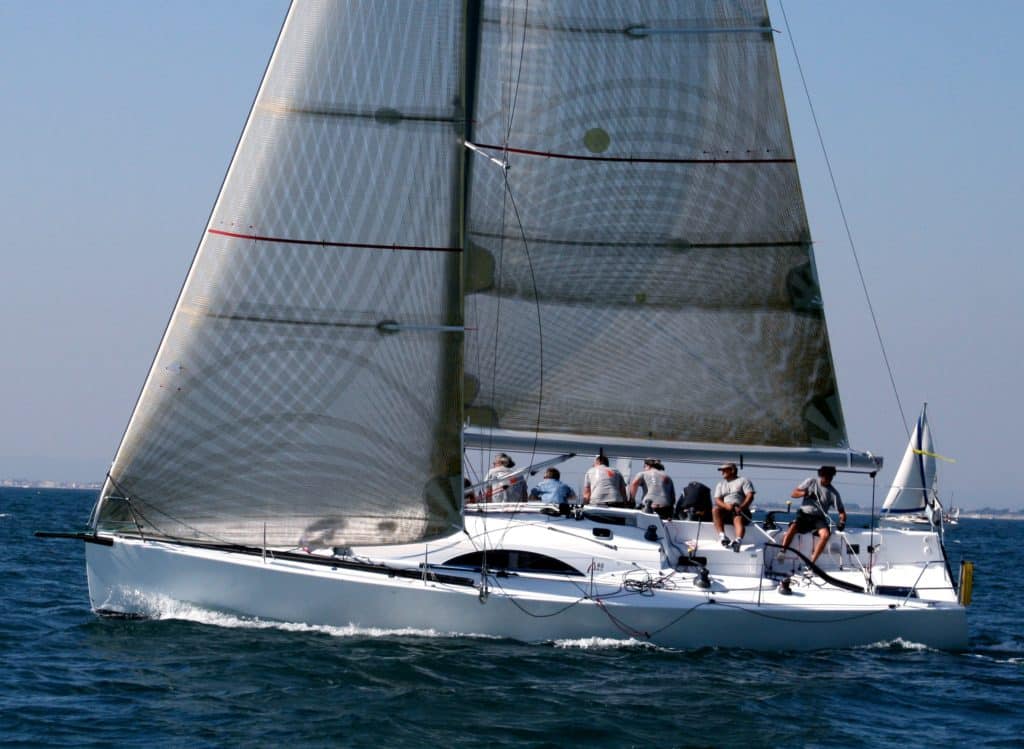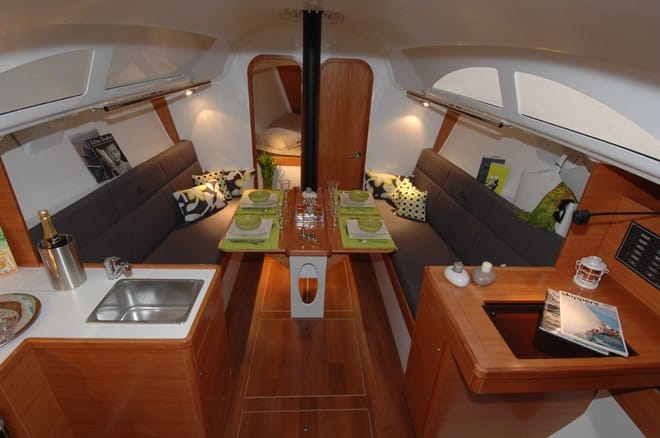
In the annals of yacht design, the interchangeable terms of “cruiser/racer” and “racer/cruiser” are fairly recent additions to the sailing lexicon. Granted, it’s somewhat of a simplification, but once upon a time, boats were meant to A) do one thing or the other, either race or cruise; or B) do both things equally well, without the need to stamp an all-encompassing label upon them.
An example of the former would be the pinched, custom I.O.R. racers of the late 1970s and the pudgy, heavy-displacement Taiwanese cruisers of the same era. An illustration of the latter would be Carlton Mitchell’s famous Finesterre, inspired by the old Cruising Club of America Rule, aboard which her skipper won three Newport-Bermuda races and also wandered all over the Caribbean.
Somewhere along the way, though on a less expansive scale, more and more sailors wanted to emulate Mitchell’s style of sailing and thus required a boat that they could competitively race in club events and regional regattas, then take the family for a fun, comfortable, two-week coastal adventure over their summer break. Throughout the 1980s, especially, there were plenty of builders that addressed these sailors’ needs, including Cal, C&C, J/Boats, Pearson, Sabre, and many others. At some point, these dual-purpose vessels came to be known as “racer/cruisers” (even though many owners never really raced them), an apt description as well as a clever marketing hook.
In contemporary sailboat design, to a large degree, we’ve returned to an era of specialization. In fact, one could make the case, based on a stroll down the docks of last fall’s U.S. Sailboat Show in Annapolis, that there are a handful of distinct classes of sailboats being offered today: Offshore cruisers and coastal cruisers (with the ubiquitous deck-saloon configuration a growing subset of each); catamarans; raceboats; and a wondrous new creation, the “daysailer” that lists for several hundred thousand dollars.
What was once a dominant player in the marketplace, the “traditional” hybrid racer/cruiser or, as it’s come to be known, the performance cruiser, is still very much on the radar (see: Boats, J/), but maybe not to the degree that it once was. As an aficionado of the pure, unparalleled joy of sailing-aboard a light but well-built boat with good sails that responds to a light touch on the helm and a bit of tweaking and trimming-to me this isn’t a particularly welcome development.
So I was gladdened, last autumn, to see the introduction of a trio of new 2009 performance cruisers in the 34- to 40-foot range, a sweet spot in the marketplace that’s also suffered a dearth of innovation as manufacturers churned out ever-larger boats with more profitable price points. The Archambault A40RC, Santa Cruz 37, and X-34 share many of the same attributes, but they’re also surprisingly diverse in several key regards. We took all three for a spin on Chesapeake Bay. Here’s what we learned.
The Racy A40RC
The French manufacturer of the slick Archambault A40RC, Archambault Boats, has been in the fiberglass-boatbuilding business since 1954, and the company took a novel approach in bringing the concept of this racy 40-footer to fruition. It commissioned the well-known Joubert/Nivelt/Mercier design team to draft four prototypes, which the company then built, sailed, and raced for a year. Make no mistake, the racing was a key component of this real-world design contest, as one of the objectives was to optimize a vessel to compete under the latest popular racing rule, the I.R.C. (which, notably, does a much better job than past rules in rewarding boats with wholesome cruising accommodations). The winning version, the A40RC (for racer/cruiser), made its North American debut last fall.
The first, unavoidable feature one notices when stepping aboard the A40 is the long, expansive cockpit, the spaciousness of which is further accentuated by the wide beam carried well aft and the open transom at the stern. This, along with the twin titanium or carbon wheels and the short cockpit seats, screams raceboat, though that isn’t necessarily a terrible thing. Racers require, more than anything else, efficient deck layouts and attendant gear for sail handling and maneuvers, and the boat is rich in top-notch hydraulics and hardware from Navtec, Lewmar, Ronstan, and Spinlock. The beamy cockpit and a suite of husky Lewmar winches provide ample space for headsail and spinnaker trim and tacks and jibes; the mainsheet and long traveler is also readily at hand, just forward of the twin helms.

Almost all the other running rigging is led aft, to a bank of clutches just forward of the rounded companionway, an ergonomically perfect station for the crew in charge of halyards, reefing lines, the boom vang, and so on. This, though, is a double-edged sword: It’s a terrific place to work, but it also requires a dedicated hand, removed from other duties, when maneuvering in close quarters.
Given the cockpit dimensions and the stylized, bulbous coachroof, the biggest surprise on the A40RC comes when one steps below and into an accommodation plan that just doesn’t seem possible when you’re viewing the boat dockside. There are two huge double berths aft, both with nifty overhead pipe berths, and a good-sized owner’s stateroom forward. The central saloon has all the necessary accoutrements: a decent galley to port, a quite good navigation station to starboard, and long settees flanking a central dining table. It’s an interior that could handle a racing crew of eight or a family of four with complete ease.
CW’s Boat of the Year judging panel had a good, hard look at the A40RC and came away impressed with the construction details. “It’s well built, with a high percentage of resin, rather than a high fiber-to-resin ratio,” said world cruiser and technical specialist Ralph Naranjo. “The laminate showed good attention to detail, with a PVC foam core and vinylester resin.” Naranjo’s one concern was the employment of balsa coring in high-load areas, but otherwise, he gave the boat high grades.
All that aside, one can’t appreciate what the A40RC is all about until you’ve hoisted sail-then, and only then, does the boat truly come alive. We sailed the boat in 8 to 11 knots of true wind and flat water in the confines of Chesapeake Bay. Upwind, at the lower end of the breeze, the boat charged along at 7 to 8 knots, with the lightest of fingertips on the wheel. Once the big masthead asymmetric kite was hoisted, in 11 knots of wind, the boat skimmed effortlessly at close to 9 knots. The factory crew of four excellent sailors got a workout while I leaned back, steered, and smiled.
That said, to get the most out of the A40RC, a crack team of top sailors was kept very busy. This is an athletic boat. Yes, in little time you could swap the racing headsail foil with a small jib furler, rig lazy jacks on the mainsail, and replace the racing inventory with sturdier canvas to go with a cruising configuration. The loads are light, and the hull is easily driven; an experienced couple could handle the boat quite easily with an autopilot. There’s a reason some builders like to call their boats “cruiser/racers,” while some choose to word it the other way around. The A40RC definitely puts the emphasis on racer.
Specs
LOA 39′ 3″ (11.98 m.)
LWL 34′ 8″ (10.54 m.)
Beam 12′ 4″ (3.75 m.)
Draft (standard) 8′ 1″ (2.48 m.)
(shoal) 7′ 2″ (2.20 m.)
Sail Area 840 sq. ft. (81 sq. m.)
Ballast 6,834 lb. (3,100 kg.)
Displacement 14,660 lb. (6,650 kg.)
Ballast/D .51
D/L 157
SA/D 22.4
Water 53 gal. (200 l.)
Fuel 20 gal. (75 l.)
Mast Height 58′ 0″ (17.7 m.)
Engine 29-hp. Nanni diesel
Designer Joubert/Nivelt/Mercier
Price $330,000
Archambault North America
(902) 476-5200
www.archambault-boats.ca








